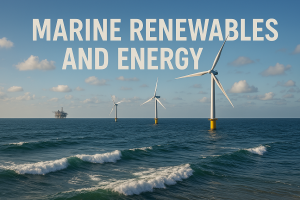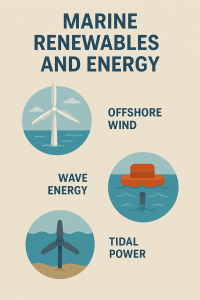Learn how wave, tidal, and offshore wind energy are revolutionizing the future of clean power. Discover market trends, technologies, and real-world applications driving the marine energy sector in 2024 and beyond.
🌍 Can the Ocean Power Our Future?
Did you know the Earth’s oceans contain enough energy to power the world — multiple times over? As the world races to reduce carbon emissions and transition away from fossil fuels, marine renewable energy is emerging as one of the most sustainable and underutilized clean energy resources.
From powerful tides and rhythmic waves to steady offshore winds, our oceans are brimming with potential — and in 2024, that potential is finally gaining momentum.
💡 Key Concepts: What Are Marine Renewables?
Marine renewable energy harnesses power from the ocean through wave energy (surface wave motion), tidal energy (rising/falling tides), and offshore wind energy (sea-based turbines). These technologies provide predictable, clean, and sustainable power, making them ideal for coastal nations and islands seeking energy independence. As climate goals tighten, marine renewables are gaining traction as a viable alternative to fossil fuels.
Marine renewable energy refers to energy derived from oceanic sources. It includes:
-
🌊 Wave energy – Harnessing surface waves to generate electricity
-
🌊 Tidal energy – Capturing energy from rising and falling tides
-
🌬️ Offshore wind energy – Using wind turbines installed at sea
These technologies offer predictable, stable, and environmentally friendly power, making them attractive for coastal countries and island nations.
📊 Ocean Energy Market Growth (2024–2034)
The marine energy sector is set to double from 2.1B(2024)to4.4B+ by 2034, growing at an 8.1% CAGR. Key drivers include government incentives, falling tech costs, and demand for energy security. Searches like “ocean energy market forecast 2034” reflect rising investor interest. Europe and Asia lead adoption, with floating wind and hybrid systems accelerating growth. According to the latest market analysis:
-
Value in 2024: USD 2.1 billion
-
Projected CAGR (2025–2034): 8.1%
-
Forecasted Value by 2034: USD 4.4+ billion
This growth is fueled by:
- Government incentives and green energy targets
- Technological innovation and falling infrastructure costs
- Growing interest in energy independence and grid diversification
🔍 Top search trend in 2024: “Ocean energy market growth forecast 2034”
🌊 Key Technologies in Marine Renewable Energy
Wave Energy systems like oscillating water columns and buoy-based converters (such as the CETO system in Australia) capture the relentless motion of surface waves, providing consistent power for remote coastal communities and even supporting desalination plants. These systems excel in regions with strong wave activity, converting the ocean’s constant movement into clean electricity with minimal environmental impact.
Tidal Energy stands out for its unmatched predictability, tied to the moon’s gravitational pull. Projects like Scotland’s MeyGen tidal array – the world’s largest tidal stream installation – demonstrate how underwater turbines can reliably power thousands of homes. Unlike other renewables, tidal energy offers near-perfect generation forecasting, making it invaluable for grid stability.
Offshore Wind continues to dominate marine renewables, with megaprojects like the UK’s Hornsea One (1.2GW capacity) pushing technological boundaries. The sector is now evolving with floating wind platforms that unlock deep-water sites previously inaccessible to traditional fixed-bottom turbines.
The future of marine energy integration lies in hybrid systems combining multiple technologies, while AI-driven predictive maintenance and digital twin simulations are dramatically improving operational efficiency and reducing costs. These innovations position marine renewables as a cornerstone of the global transition to sustainable energy.
1. 🌊 Wave Energy
How it works: Devices capture the motion of surface waves using buoys or oscillating water columns.
Applications:
- Coastal power for remote communities
- Integration with desalination plants
- Off-grid backup systems
Example: CETO Wave Project in Australia uses submerged buoys to drive pumps and generate electricity onshore.
2. 🌊 Tidal Energy
How it works: Turbines are placed underwater in areas with strong tidal flows. As tides rise and fall, they turn the turbines.
Advantages:
- Highly predictable (linked to lunar cycles)
- Minimal visual impact compared to wind farms
Example: MeyGen Tidal Stream Project in Scotland powers thousands of homes using underwater turbines.
3. 🌬️ Offshore Wind Energy
How it works: Turbines fixed to the seabed (or floating) generate electricity using consistent ocean winds.
Global Leader: The UK, followed by China, Germany, and the U.S.
Notable Example: Hornsea Project One in the UK — the world’s largest offshore wind farm, generating over 1.2 GW of energy.
🌱 Why Marine Energy Matters
Marine renewables offer zero-emission power, minimal land use, and coastal job creation. Island nations benefit from energy access, while hybrid systems (wave + solar + storage) enhance grid stability. As IRENA notes, “marine energy can be the backbone of clean coastal economies.”
✔️ Environmental Benefits:
- No air pollution or greenhouse gases
- Minimal land use or deforestation
- Complementary to solar and onshore wind power
✔️ Economic & Social Benefits:
- Local job creation in coastal areas
- Energy access for island nations
- Diversification of national energy grids
💬 Quote: “Marine energy can be the backbone of clean coastal economies” — International Renewable Energy Agency (IRENA)
🔮 Emerging Trends & Future Outlook
2024’s top trends include floating wind farms (deep-water expansion), AI-powered predictive maintenance, and hybrid ocean-solar-storage systems. Governments (EU, UK, South Korea) are boosting R&D funding, signaling long-term commitment. The future lies in scalable, eco-friendly marine tech for a decarbonized world.
📌 Top Emerging Trends in 2024:
-
Floating wind platforms – ideal for deep water zones
-
Hybrid systems – combining wave + solar + storage
-
AI & digital twins – for predictive maintenance of marine turbines
-
Blue economy investments – supporting sustainable ocean-based industries
📊 Governments in the EU, UK, Canada, and South Korea have all pledged increased funding for marine energy R&D in 2025 budgets.
🧭 Real-World Applications
| Use Case | Technology | Region |
|---|---|---|
| Off-grid island electrification | Tidal + solar hybrid | Indonesia |
| Green hydrogen production | Offshore wind | Denmark |
| Coastal energy independence | Wave energy | Portugal |
| Floating desalination | Wave-powered reverse osmosis | Canary Islands |
❓ FAQs – People Also Ask
❓What is marine renewable energy?
It is clean energy generated from ocean-based resources like waves, tides, and offshore wind.
❓Is marine energy reliable?
Yes! Tidal and offshore wind are highly predictable, making them more reliable than solar in some regions.
❓What countries are investing the most in ocean energy?
The UK, France, Canada, China, and South Korea are leading in marine energy investment and development.
❓What’s the difference between offshore wind and tidal power?
Offshore wind uses air currents above the sea, while tidal energy captures underwater movement from tides.
❓How does marine energy affect the environment?
Most marine energy systems have low to moderate ecological impacts, especially when designed to avoid sensitive habitats.
Conclusion: Marine Energy – A Rising Tide of Opportunity
Marine renewables are no longer science fiction. In 2024, they represent a critical solution for climate action, coastal energy security, and global decarbonization goals.
With continued investment, smarter infrastructure, and international cooperation, the oceans could soon power millions of homes, businesses, and industries worldwide.
⚡ Learn more about renewable energy in the maritime sector at MaritimeEducation.com



